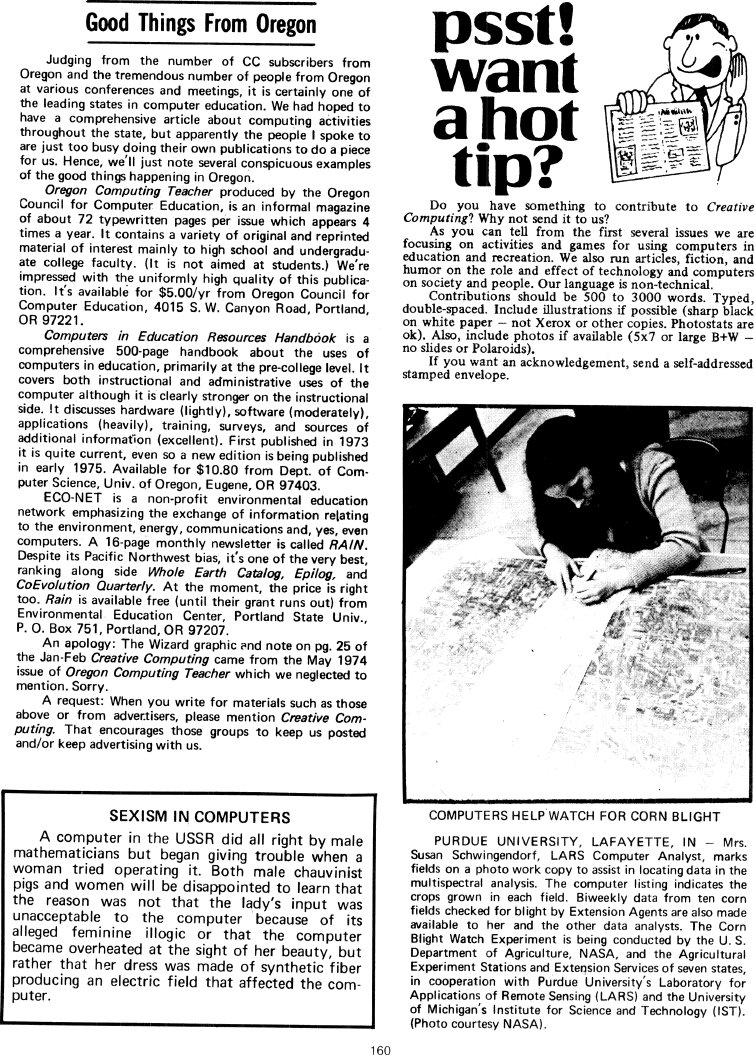The Best of Creative Computing Volume 1 (published 1976)
Good Things From Oregon (Computer-oriented publications from Oregon)

Good Things From Oregon
Judging from the number of CC subscribers from
Oregon and the tremendous number of people from Oregon
at various conferences and meetings, it is certainly one of
the leading states in computer education. We had hoped to
have a comprehensive article about computing activities
throughout the state, but apparently the people l spoke to
are just too busy doing their own publications to do a piece
for us. Hence, we'll just note several conspicuous examples
of the good things happening in Oregon.
Oregon Computing Teacher produced by the Oregon
Council for Computer Education, is an informal magazine
of about 72 typewritten pages per issue which appears 4
times a year. It contains a variety of original and reprinted
material of interest mainly to high school and undergraduate
college faculty. (It is not aimed at students.) We're
impressed with the uniformly high quality of this publication.
It's available for $5.00/yr from Oregon Council for
Computer Education, 4015 S. W. Canyon Road, Portland,
OR 97221.
Computers in Education Resources Handbook is a
comprehensive 500-page handbook about the uses of
computers in education, primarily at the pre-college level. It
covers both instructional and administrative uses of the
computer although it is clearly stronger on the instructional
side. It discusses hardware (lightly), software (moderately),
applications (heavily), training, surveys, and sources of
additional information (excellent). First published in 1973
it is quite current, even so a new edition is being published
in early 1975. Available for $10.80 from Dept. of Computer
Science, Univ. of Oregon, Eugene, OR 97403.
ECO-NET is a non-profit environmental education
network emphasizing the exchange of information relating
to the environment, energy, communications and, yes, even
computers. A 16-page monthly newsletter is called RAIN.
Despite its Pacific Northwest bias, it's one of the very best,
ranking along side Whole Earth Catalog, Epilog, and
CoEvolution Quarterly. At the moment, the price is right
too. Rain is available free (until their grant runs out) from
Environmental Education Center, Portland State Univ.,
P. 0. Box 751, Portland, OR 97207.
An apology: The Wizard graphic and note on pg. 25 of
the Jan-Feb creative counting came from the May 1974
issue of Oregon Computing Teacher which we neglected to
mention. Sorry.
A request: When you write for materials such as those
above or from advertisers, please mention Creative Computing.
That encourages those groups to keep us posted
and/or keep advertising with us.
***
SEXISM IN COMPUTERS
A computer in the USSR did all right by male
mathematicians but began giving trouble when a
woman tried operating it. Both male chauvinist
pigs and women will be disappointed to learn that
the reason was not that the lady's input was
unacceptable to the computer because of its
alleged feminine illogic or that the computer
became overheated at the sight of her beauty, but
rather that her dress was made of synthetic fiber
producing an electric field that affected the computer.
***
post! wanted a hot tip?
[Image]
Do you have something to contribute to Creative
Computing? Why not send it to us?
As you can tell from the first several issues we are
focusing on activities and games for using computers in
education and recreation. We also run articles, fiction, and
humor on the role and effect of technology and computers
on society and people. Our language is non-technical.
Contributions should be 500 to 3000 words. Typed,
double-spaced. Include illustrations if possible (sharp black
on white paper - not Xerox or other copies. Photostats are
ok). Also, include photos if available (5x7 or large B+W no slides or
Polaroids).
If you want an acknowledgement, send a self-addressed
stamped envelope.
[Image]
***
COMPUTERS HELP WATCH FOR CORN BLIGHT
PURDUE UNIVERSITY, LAFAYETTE, IN - Mrs.
Susan Schwingendorf, LARS Computer Analyst, marks
fields on a photo work copy to assist in locating data in the
multispectral analysis. The computer listing indicates the
crops grown in each field. Biweekly data from ten corn
fields checked for blight by Extension Agents are also made
available to her and the other data analysts. The Corn
Blight Watch Experiment is being conducted by the U. S.
Department of Agriculture, NASA, and the Agricultural
Experiment Stations and Extension Services of seven states,
in cooperation with Purdue University's Laboratory for
Applications of Remote Sensing (LARS) and the University
of Michigan's Institute for Science and Technology (IST).
(Photo courtesy NASA).


